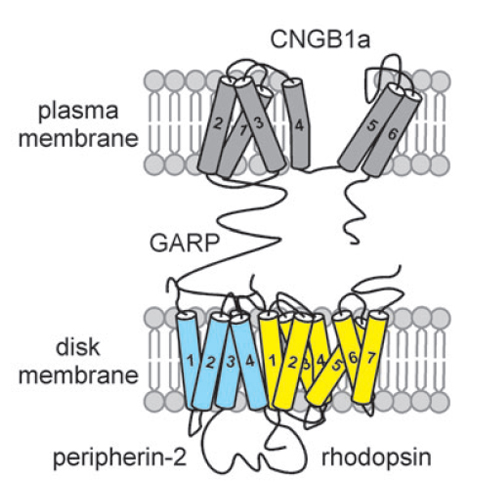Peripherin-2 couples rhodopsin to the CNG channel in outer segments of rod photoreceptors
24-Jun-2014
Human Molecular Genetics, 2014, doi: 10.1093/hmg/ddu323, 1–9 published on 24.06.2014
Human Molecular Genetics, online article
Human Molecular Genetics, online article
Outer segments (OS) of rod photoreceptors are cellular compartments specialized in the conversion of light into electrical signals. This process relies on the light-triggered change in the intracellular levels of cyclic guanosine monophosphate (cGMP), which in turn controls the activity of cyclic nucleotide-gated (CNG) channels in the rod OS plasma membrane. The rod CNG channel is a macromolecular complex that in its core harbors the ion-conducting CNGA1 and CNGB1a subunits. To identify additional proteins of the complex that interact with the CNGB1a core subunit we applied affinity purification of mouse retinal proteins followed by mass spectrometry. In combination with in vitro and in vivo co-immunoprecipitation and fluorescence resonance energy transfer (FRET) we found that the tetraspanin peripherin-2 links CNGB1a to the light-detector rhodopsin. Using immunoelectron microscopy we found that this peripherin-2/rhodopsin/CNG channel complex localizes to the contact region between the disk rims and the plasma membrane. FRET measurements revealed that the fourth transmembrane domain (TM4) of peripherin-2 is required for the interaction with rhodopsin. Quantitatively, the binding affinity of the peripherin-2/rhodopsin interaction was in a similar range as that observed for rhodopsin dimers. Finally, we demonstrate that the p.G266D retinitis pigmentosa mutation found within TM4 selectively abolishes the binding of peripherin-2 to rhodopsin. This finding suggests that the specific disruption of the rhodopsin/peripherin-2 interaction in the p.G266D mutant might contribute to the pathophysiology in affected persons.











